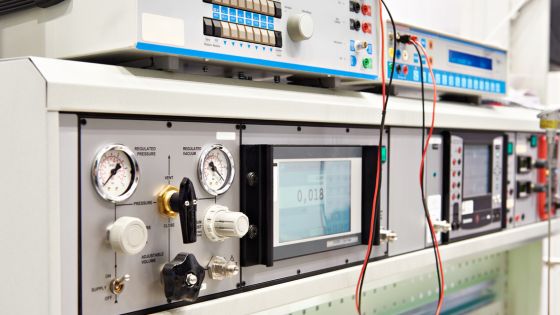Key Takeaways:
- Metrology equipment refers to instruments used for measurement and calibration in industries.
- Metrology plays a vital role in manufacturing, aerospace, automotive, and medical industries.
- Metrology equipment has evolved with advancements in technology, including the introduction of digital displays and software.
- Essential metrology tools include calipers, micrometers, gauge blocks, CMMs, and optical comparators.
- Innovative technologies in metrology include laser scanning, CAI, CMMs with articulating arms, and 3D imaging.
- Considerations when choosing metrology equipment include measurement range, accuracy, usability, and support.
- Metrology equipment works through direct measurement, non-contact measurement, interferometry, and coordinate systems.
- Accuracy and precision are crucial in metrology, achieved through calibration and traceability.
- Industry 4.0 has impacted metrology through IoT integration and AI-driven analytics.
- Advancements in non-contact metrology include white light scanning and structured light scanning.
- The future of metrology involves AI and automation for data analysis and process optimization.
1. Overview of Metrology Equipment
Understanding the Basics
What is metrology equipment? Metrology equipment refers to a range of instruments and devices used for measurement and calibration purposes in various industries. The term “metrology” originates from the Greek word “metron,” meaning measure. It involves the science of measurement and the precise quantification of physical quantities.
At its core, metrology equipment enables accurate and precise measurement of dimensions, angles, shapes, and other physical properties. It plays a crucial role in quality control, research and development, and manufacturing processes.


Importance of Metrology in Various Industries
Metrology plays a vital role in various industries, ensuring product quality, reliability, and safety. Here are a few examples of industries that heavily rely on metrology:
- Manufacturing: Metrology equipment is essential in manufacturing industries to maintain consistent product quality, ensure compliance with industry standards, and minimize variations in product dimensions.
- Aerospace: The aerospace industry relies on metrology for the precise measurement of aircraft parts, ensuring their accurate alignment, fit, and functionality.
- Automotive: Metrology equipment is crucial for automotive manufacturers to measure and validate critical components’ dimensions, ensuring vehicle safety and performance.
- Medical: In the medical field, metrology equipment is used for precision measurements in medical device manufacturing, ensuring accuracy and reliability in healthcare technologies.
The Evolution of Metrology Equipment
Metrology equipment has come a long way since its early beginnings. Traditionally, basic tools like rulers, calipers, and micrometers were used for measurements. However, with advancements in technology, metrology equipment has become more sophisticated and accurate.
The introduction of electronic components and digital displays revolutionized metrology equipment. Digital calipers, height gauges, and various other instruments provided precise measurements with greater convenience and readability.
In recent years, the emergence of metrology software and coordinate measuring machines (CMMs) has further enhanced measurement capabilities. These advanced systems enable complex measurement processes, automation, and data analysis, improving productivity and quality control.
2. Types of Metrology Equipment
Exploring Essential Metrology Tools
Metrology encompasses a wide range of tools and equipment, each designed for specific measurement requirements. Here are some essential metrology tools:
- Calipers: Calipers are versatile devices used to measure dimensions, both internal and external, with high accuracy.
- Micrometers: Micrometers are precision instruments used to measure small distances or thicknesses.
- Gauge Blocks: Gauge blocks are standardized units used for calibrating measuring equipment and verifying their accuracy.
- Height Gauges: Height gauges measure the vertical distance between a reference surface and the object being measured.
- Coordinate Measuring Machines (CMMs): CMMs are highly sophisticated systems that use tactile or non-contact probes to perform precise measurements of complex objects.
- Optical Comparators: Optical comparators use optical magnification and illumination to inspect and measure the dimensions of an object.
Innovative Technologies in Metrology
Metrology has embraced various innovative technologies to improve measurement accuracy and efficiency. Some notable advancements include:
- Laser Scanning: Laser scanning technology enables the fast and accurate capture of three-dimensional shape and geometry by emitting laser beams and analyzing their reflections.
- Computer-Aided Inspection (CAI): CAI combines metrology equipment with computer-aided design (CAD) models to perform automated inspections and compare measured data with expected dimensions.
- Coordinate Measuring Machines (CMMs) with Articulating Arms: These portable CMMs utilize articulated arms to measure objects with flexibility and precision, making them suitable for on-site measurements.
- 3D Imaging: 3D imaging technologies such as photogrammetry and structured light scanning allow for the creation of digital 3D models for accurate measurement and comparison.
Choosing the Right Equipment for Your Needs
When selecting metrology equipment, it’s essential to consider various factors such as the measurement requirements, accuracy, repeatability, and budget. Here are some key considerations:
- Measurement Range: Ensure the equipment can handle the range of measurements needed for your specific applications.
- Accuracy and Precision: Look for equipment with a high level of accuracy and precision to meet your measurement tolerances.
- Usability: Consider the ease of use, user interface, and software compatibility to ensure efficient operation.
- Support and Maintenance: Check the availability of technical support, software updates, and calibration services to maintain the equipment’s performance.
3. How Metrology Equipment Works
Principles and Techniques of Measurement
Metrology equipment relies on various principles and techniques to achieve accurate measurements. Here are some commonly used methods:
- Direct Measurement: The most straightforward method involves physically touching the object being measured with the instrument to obtain its dimensions.
- Non-Contact Measurement: Non-contact methods such as laser scanning, optical sensors, and vision systems capture measurements without touching the object, preserving its integrity and reducing the risk of damage.
- Interferometry: Interferometry measures changes in wavefronts to determine the object’s dimensions or surface characteristics with exceptional accuracy.
- Coordinate Systems: Coordinate systems, such as Cartesian, polar, and cylindrical coordinates, provide a reference framework for precise location and measurement.
Accuracy and Precision in Metrology
Accuracy and precision are crucial aspects of metrology. While accuracy refers to the proximity of a measurement to the true value, precision refers to the repeatability and consistency of a measurement.
To ensure accuracy, metrology equipment undergoes regular calibration and traceability to national or international standards. Calibration involves comparing the measurements taken by the instrument with a known value, making necessary adjustments if required.
Precision is determined by the resolution and sensitivity of the instrument. Higher precision allows for better differentiation of small changes in measurements, resulting in more accurate data analysis and decision-making.
Calibration and Traceability in Metrology
Calibration is a vital process in metrology that establishes the relationship between the measurements made by a particular instrument and the known standards. The calibration process involves comparing measurement values obtained from the instrument with those obtained from a reference standard.
Traceability ensures the reliability and accuracy of metrology equipment by establishing a documented chain of measurements that can be related to appropriate national or international standards. It enables the guarantee of measurement comparability and the establishment of confidence in the equipment’s accuracy.
4. Latest Trends in Metrology Equipment
Industry 4.0 and its Impact on Metrology
The advent of Industry 4.0, also known as the Fourth Industrial Revolution, has significantly influenced metrology equipment. Industry 4.0 focuses on the digitization and automation of manufacturing processes, integrating advanced technologies like the Internet of Things (IoT), big data, and artificial intelligence (AI).
Metrology equipment is now equipped with IoT capabilities, enabling real-time data collection, analysis, and remote monitoring. This integration improves efficiency, reduces downtime, and enhances quality control by identifying potential issues in real-time.
AI-driven analytics help interpret large volumes of metrology data, identifying trends, patterns, and anomalies for predictive maintenance and process optimization. This data-driven approach enables proactive decision-making and continuous improvement.
Advancements in Non-Contact Metrology
Non-contact metrology methods have witnessed significant advancements in recent years, expanding measurement possibilities and improving efficiency.
Technologies such as white light scanning, structured light scanning, and confocal microscopy enable non-contact measurement of complex surfaces, transparent materials, and delicate objects without causing any damage.
These non-contact methods provide faster data acquisition, high-resolution imaging, and the ability to measure intricate geometries, making them ideal for industries like aerospace, automotive, and electronics.
The Future of Metrology: Artificial Intelligence and Automation
The future of metrology lies in the integration of artificial intelligence and automation. AI algorithms coupled with metrology equipment can analyze complex measurement data, identify anomalies, and optimize measurement processes.
Automation further enhances the metrology process by reducing human error, increasing productivity, and streamlining workflows. Robotic systems and machine learning algorithms enable the automatic execution of measurements, data analysis, and decision-making.
As technology continues to advance, metrology equipment will become more interconnected, intelligent, and capable of adapting to evolving industry demands.
Demystifying metrology equipment is crucial for understanding its significance in various industries. Whether it’s ensuring precise manufacturing, enabling groundbreaking medical advancements, or designing cutting-edge aerospace technologies, metrology plays a critical role in shaping our world.
FAQ
1. Question: What is Metrology Equipment? – Metrology equipment refers to a range of instruments and devices used for measurement and calibration purposes in various industries. It enables accurate and precise measurement of dimensions, angles, shapes, and other physical properties.
2. Question: What are some essential metrology tools? – Essential metrology tools include calipers, micrometers, gauge blocks, height gauges, coordinate measuring machines (CMMs), and optical comparators.
3. Question: What are some innovative technologies in metrology? – Innovative technologies in metrology include laser scanning, computer-aided inspection (CAI), CMMs with articulating arms, and 3D imaging.
4. Question: What factors should be considered when choosing metrology equipment? – When choosing metrology equipment, factors to consider include measurement range, accuracy, usability, and support.
5. Question: How does metrology equipment work? – Metrology equipment works through direct measurement, non-contact measurement, interferometry, and coordinate systems.
6. Question: What is the difference between accuracy and precision in metrology? – Accuracy refers to the proximity of a measurement to the true value, while precision refers to the repeatability and consistency of a measurement.
7. Question: What is calibration and traceability in metrology? – Calibration involves comparing measurement values obtained from an instrument with those obtained from a reference standard. Traceability ensures the reliability and accuracy of metrology equipment by establishing a documented chain of measurements.
8. Question: What are the latest trends in metrology equipment? – The latest trends in metrology equipment include Industry 4.0 integration with IoT and AI-driven analytics, advancements in non-contact metrology, and the future integration of artificial intelligence and automation.


























